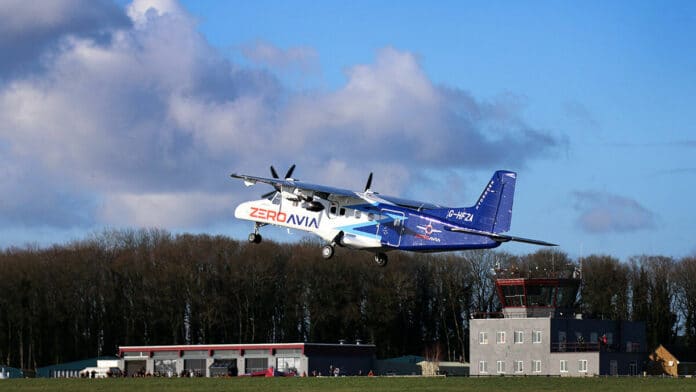ZeroAvia, an electric aircraft propulsion specialist, has successfully completed the maiden flight of its 19-seat Dornier 228 testbed aircraft retrofitted with a full-size prototype hydrogen-electric powertrain.
The flight took place from the company’s R&D facility at Cotswold Airport in Gloucestershire, UK, and lasted 10 minutes. This milestone moves ZeroAvia forward on the way to meeting the target of commercial flights using only hydrogen fuel cell power by 2025 and scaling the engine technology to larger airframes.
According to ZeroAvia, the aircraft developed as part of the HyFlyer II project is the largest hydrogen-electric aircraft in the world to date. The development of this technology is an important part of the HyFlyer II project, supported by the British Government’s Aerospace Technology Institute (ATI), aimed at creating a zero-emission propulsion system for aircraft with capacities from 9 to 19 passengers. The maiden flight is now to be followed by a series of further test flights.
This latest achievement follows ZeroAvia’s previous world-first milestones, starting with 6-seat prototype flights of a Piper M-Class airframe in 2019. Just over two years ago, ZeroAvia conducted the first of over 30 flights of a six-seater Piper Malibu aircraft modified with the integration of a Fuel Cell powertrain with a 250 kW electric motor.
The 2020 prototype was a part of the HyFlyer I program in the UK. Unlike the previous tech demonstrator program, ZeroAvia’s 600kW engine being developed under HyFlyer II is a commercial-intent program.
The Dornier 228 is a twin-engine turboprop built by the German manufacturer Dornier between 1981 and 1998. For the recent tests, the twin-engine aircraft was retrofitted to incorporate ZeroAvia’s hydrogen-electric engine on its left wing, which then operated alongside a single Honeywell TPE-331 stock engine on the right.
For this test machine, the hydrogen-electric powertrain comprises two fuel cell stacks, with lithium-ion battery packs providing peak power support during take-off and adding additional redundancy for safe testing. In this testbed configuration, hydrogen tanks and fuel cell power generation systems were housed inside the cabin. In a commercial configuration, external storage would be used and the seats restored.
The modified Dornier 228 will conduct further test flights in the future. The goal is to be able to certify this solution and then make it available on commercial aircraft of this size by 2025. At the same time, the company is also working on 2-5 MW electric motors that can be used on aircraft with up to 90 passengers.
